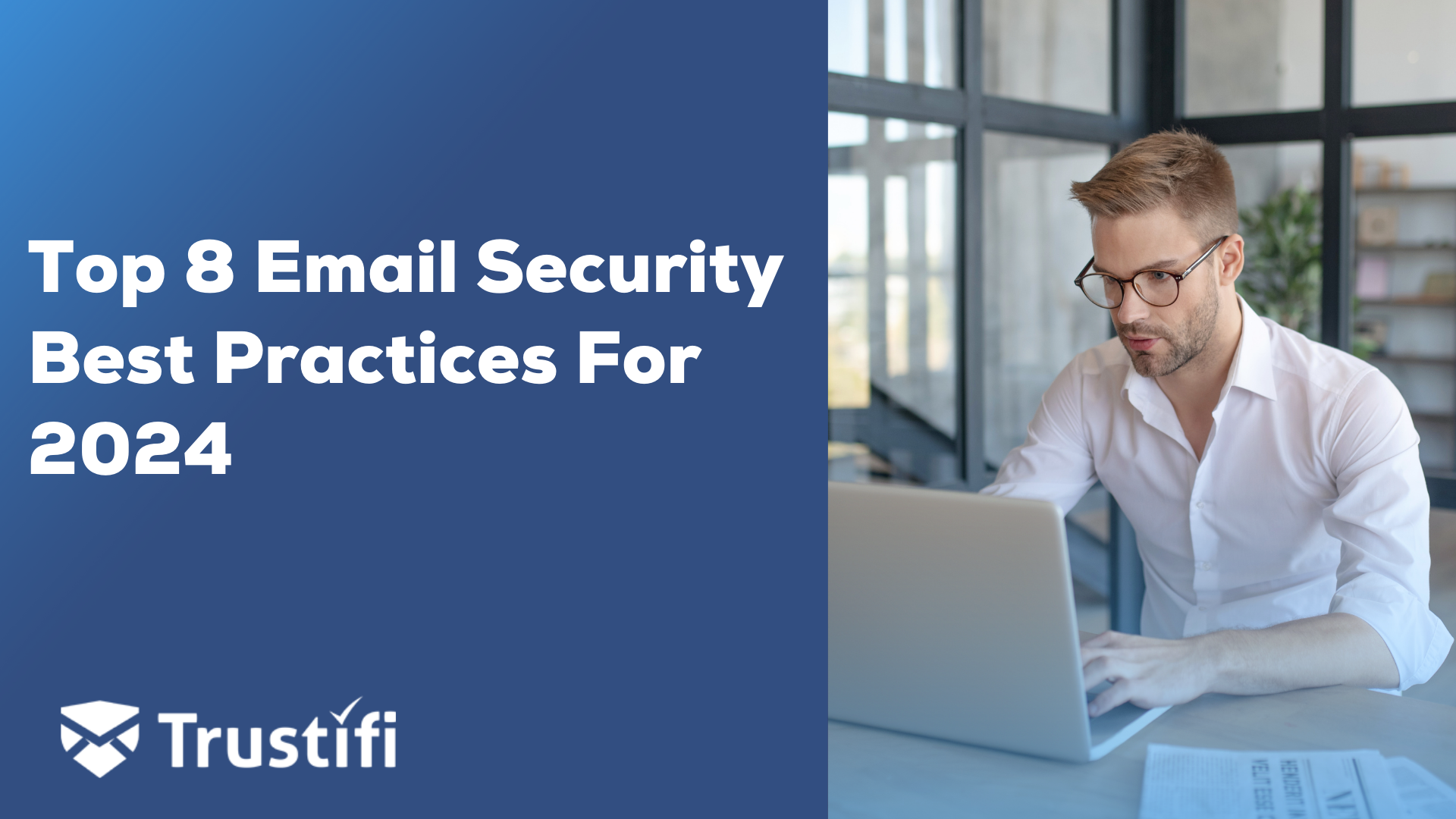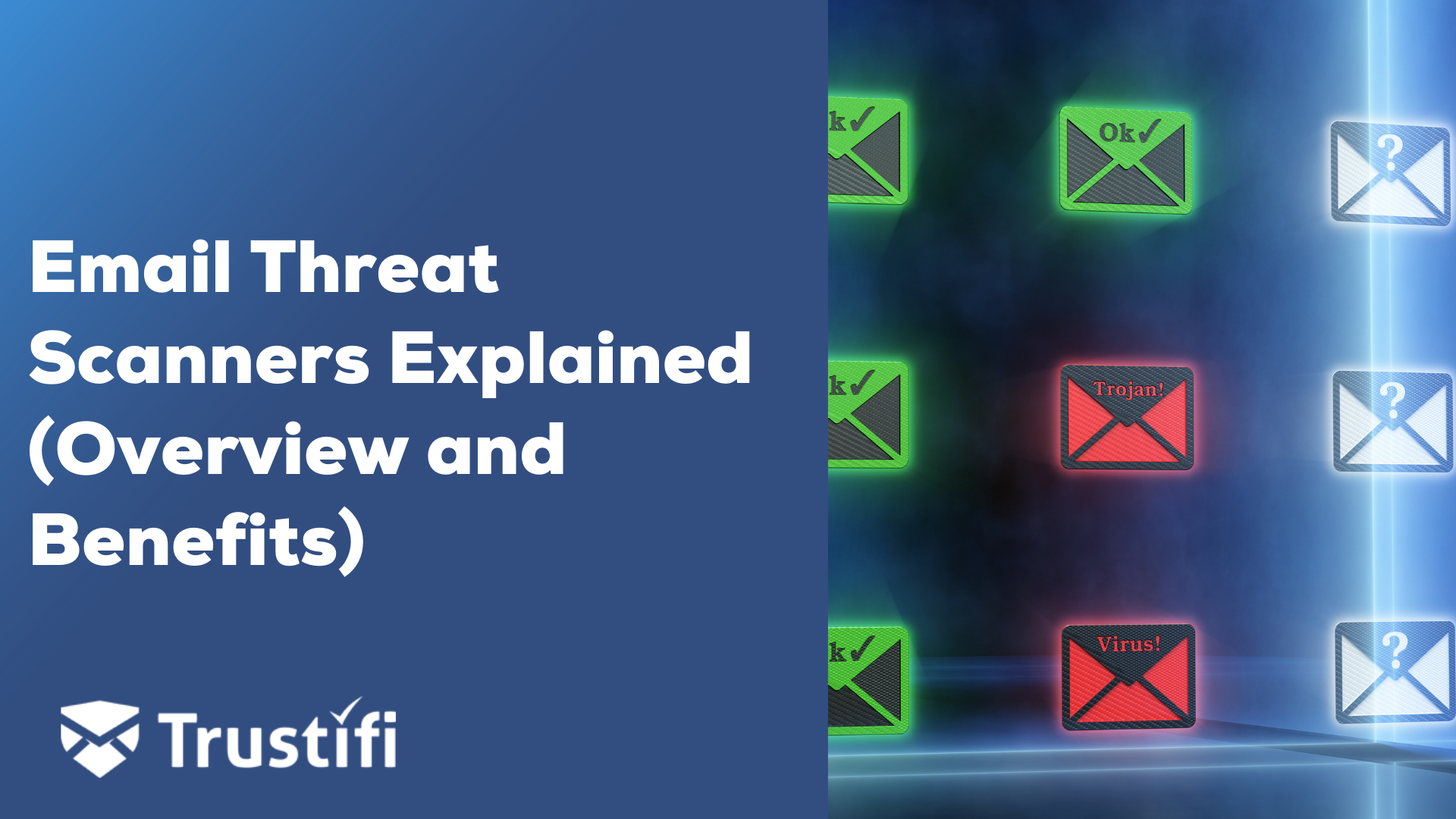Email security in 2024 developed well beyond basic filtering and behavior analytics. Organizations focusing on protecting their email communications, users, and data need an accurate, multi-faceted approach. Relying on standalone devices or virtual security applications operating in a silo will do very little to prevent next-generation email attacks generated by WormGPT, FraudGPT, DarkGPT, and ChatGPT.

Trustifi, a global leader in email security, delivers several fully integrated protection layers within its cloud-based platform powered by artificial intelligence (AI). These integrated protection layers extend more excellent protection to your organization.
Email security solutions like Trustifi deliver eight exceptional protections and capabilities to fortify their clients’ critical data, protect their users from attacks, and provide a lower security operations cost model.
Understanding Email Security.
Phishing attacks pose a significant security threat to businesses. Spear-phishing, whaling, and clone attacks continue to affect users globally. Hackers targeting specific people or CEOs continue to challenge security engineers.
Today, email attacks are not just single-threaded vectors targeting a specific user. Next-generation email attacks are now part of a more complex kill chain. Hackers use this kill chain to combine several elements to reach their ultimate goal.
Powered by adversarial AI, hackers create a series of kill chain attacks and alter them based on real-time feedback. This strategy continues to affect global organizations that rely on legacy email security solutions not equipped with AI or machine learning functions. Email security solutions must bring several layers of protection to stop these near real-time attack vectors.
What Are Some Common Threats Embedded Within an Email Attack Kill Chain?

An organization’s cybersecurity and email security prevention strategy must account for these attack vectors.
Here is a breakdown of common attack vectors within a kill chain.
- Reconnaissance — Hackers will use various scanning tools to detect exposed host-based platforms susceptible to exploitation. These exploits commonly occur against SaaS-based email security platforms.
- Weaponization – “After hackers discover vulnerable targets within the email security platform, they create malware to exploit the target platform.”
- Delivery —” 97% of malware is delivered through email phishing attacks.” These well-crafted emails contain malicious links or malware files impersonating PDF documents sent as attachments.
- Exploitation – Hackers lure the email recipient to click the link or download the rogue attachment.
- Installation — Once the victims click the link, they become prompted to change their password or download a file. Once these actions are completed, the hacker can access the exploited hosts, load malware, or steal cached credentials.
- Command and Control (C2) — Once the malware file is installed, the program will attempt to communicate outbound to a hacker control server, requesting additional instructions or downloading malicious content. This malware could also try to use the email client to exfiltrate data.
- Attack Execution Results — because of this successful attack kill chain sequence, the hacker now has control of a host within the internal network and the ability to move laterally. Ransomware is an example of a lateral-based attack. This malware propagates within its victim’s subnets and networks. Most ransomware attacks start with email phishing attacks.
What Are The Top 8 Email Security Best Practices Designed to Stop a Kill Chain Attack?
Enabling only one layer of protection or relying on separate protection layers operating independently will increase the success of attacks. Stopping business email compromise (BEC), spam emails and other malicious activities requires additional layers of email security.
Here are the top 8 email security best practices and how they can stop various stages within a kill chain
(1) Strong Authentication.
Robust password schemes and multi-factor authentication (MFA) help prevent hackers from executing reconnaissance against various hosts, logging into admin accounts, or looking for cached passwords to applications or other adjacent systems. MFA is also used to help ensure the secure delivery of all email messages from within the organization.
(2) Securing Connections.
Email security solutions secure connections via HTTPS to protect users’ access to various tools, including searching the email archives and releasing quarantine messages. Management consoles also use MFA to protect access to their platforms, including email security platforms. Blocking unauthorized connections also prevents outbound connections from malware.exe files to the hackers’ command-and-control server.
(3) Handling Suspicious Emails.
At the core of email security is scanning all emails and identifying and blocking malicious messages, phishing, or rogue attachments. Email security solutions powered by AI and ML are essential in detecting adversarial AI email phishing content. Advanced email security stops the delivery of email threats, such as rogue attachments in emails, and blocks malicious email links.
(4) Email Encryption.
Most compliance regulations and privacy mandates require email encryption to be enabled. Healthcare providers, financial services firms, education, and government organizations must ensure that all data communicated through email is encrypted. Encryption of all email outbound prevents hackers from achieving their attack execution and objectives.
(5) Data Leakage Prevention.
Data loss prevention (DLP), similar to email encryption, is required by several mandates, including GPDR, PCI-DSS, HIPAA, and CCPA. Hackers leveraging the newly loaded malware.exe file will attempt to steal data using FTP or access the local email client. DLP policies scan all outbound email messages for data leakage issues. DLP helps stop hackers from executing one of their core objectives: data theft.
(6) Regular Updates and Maintenance for Antivirus and Anti-malware.
Avoiding the installation of rogue files starts with an organization investing in a solid SecOps team, incident response processes, and patch management. Patching all endpoint devices, SaaS application hosts, network devices, and databases is critical to preventing malware from being downloaded and installed. Patching antivirus software, anti-malware, and anti-phishing engines block 99% of all spam messages and other potential threats.
(7) Employee Education and Training.
Security awareness training is one of the most underutilized security adaptive controls. Using engaging and authentic email security training helps reduce social engineering attacks, educates users not to click on malicious links, and assists with developing a rich proactive cybersecurity culture. Well-trained user education also helps stop malware exploitation, credential theft, and data loss.
(8) Monitoring and Reporting.
SaaS-based email security platforms, critical applications, and essential network devices become subject to scanning and exploitation without proper monitoring and reporting. Organizations need to ensure their vital systems are monitored and enabled with automated threat modeling reporting and incident response management to prevent the weaponization of an email kill chain.
Advanced Email Security Tools and Technology.
The email security market continues to develop as more providers release their various AL and ML defensive tools. These new tools, including existing DLP, data tokenization, email archiving, account takeover prevention, advanced security awareness training, and MFA support, need to work together, not as standalone solutions.
These new advanced tools become bundled in Microsoft 365 and Google Workstation packages. Some clients choose to enable only certain security features from these providers.
Which solution works best?

The answer has little to do with which solution is best; the better question is which solution integrates better. Organizations using Microsoft 365 or Google may enable email encryption or MFA while leveraging integrated cloud email security (ICES) solutions to email encryption, DLP, and security awareness training.
Choosing The Email Security Solution.
Organizations must make critical decisions about investing in the eight email security best practices to stop the seven kill chain steps. Anything less will have little value in preventing next-generation email attacks.
Selecting which email security solution starts with your success criteria is critical.
- Do all the solutions support your email security policy?
- Does the solution support your company email and employees’ email?
- Does the solution integrate well with Microsoft 365 and Google Workspaces?
- What types of email encryption does each solution support?
- Is the employee training offered static or dynamic content-based?
- Each solution supports What encryption standards?
First, the right solution needs to align with your cybersecurity requirements. Many solutions have SMB, healthcare, or financial services templates. These templates are helpful; however, if the customization feature is challenging, these solutions will lead to air gaps in security protection against email scams or attacks.
Solutions with a track record of being cloud-first and full integration with the eight best practices are the optimal solution. Solutions like Trustifi bundle the entire solution into a simplified pricing model, not a complex tiered approach.
Ultimately, the email security solution needs to be easy to use, accessible to management, and have access to continuous innovations without additional cost.
Conclusion.
Trustifi’s cloud-based strategy, with an advanced AI email security platform and tight integrations between the various protection layers at low-cost points, continues to be ideal for SMB and mid-enterprise clients.
The core of Trustifi is innovation.
Their marketing leadership in email security helps clients stop attacks by leveraging Trustifi’s highly effective AI and ML defensive capabilities. Its recently launched security awareness training module and its support for seamless integration between DLP and email encryption answer the question, “What is the ideal email security solution?”
The answer? Trustifi.
Do the Math!
Fact: Organizations that invest in Trustifi email security powered by AI and ML and follow the eight best practices help prevent the seven stages of a kill chain.Get Started With Trustifi Today – Easy, Affordable, and Comprehensive
Whether you are looking for an extra layer of protection in your existing email environment or a full-suite solution, the expertise and simplicity Trustifi offers will exceed your expectations. Let’s discuss pricing and a customized email security plan for you.
Request a demo today!


